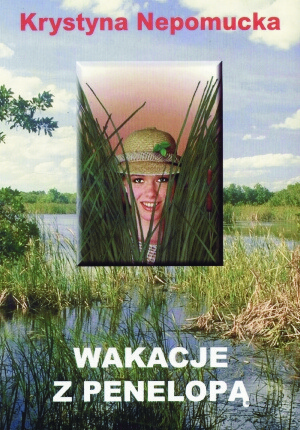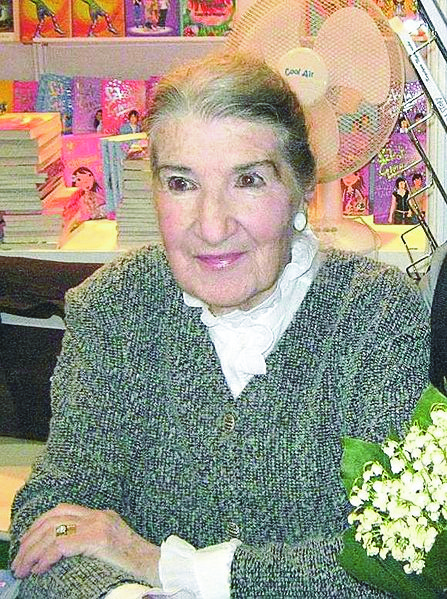Title of the work
Country of the First Edition
Country/countries of popularity
Original Language
First Edition Date
First Edition Details
Krystyna Nepomucka, Wakacje z Penelopą. Łódź: Akapit Press, 1998, 191 pp.
ISBN
Genre
Novels
Target Audience
Young adults (Teenagers)
Cover

Cover design by Zbigniew Janeczek.
Author of the Entry:
Summary: Maria Kruhlak, University of Warsaw, maria.kruhlak@student.uw.edu.pl
Analysis: Marta Pszczolińska, University of Warsaw, m.pszczolinska@al.uw.edu.pl
Peer-reviewer of the Entry:
Katarzyna Marciniak, University of Warsaw, kamar@al.uw.edu.pl
Elżbieta Olechowska, University of Warsaw, elzbieta.olechowska@gmail.com

Photograph by Sławek, retrieved from Wikipedia Commons (accessed: January 21, 2021).
Krystyna Nepomucka
, 1920 - 2015
(Author)
Studied medicine, arts, Polish literature and management. As a writer, she made her debut in 1945 in the Upper Silesian press, but in the radio broadcast Wspomnienia Krystyny Nepomuckiej [Krystyna Nepomucka’s Memories], prepared by Bogumiła Prządka, she says factiously that she wrote her first book at the age of three. Author of over 30 novels and numerous articles, Krystyna Nepomucka is currently considered one of the important Polish women authors in the 20th century. She also worked as an editor for the Western Press Agency and for the Polish Radio, but owes her popularity and recognition to a series of books entitled Niedoskonałości i doskonałości [Im- perfections and Perfections] launched by the novel Małżeństwo niedoskonałe [Imperfect Marriage], 1960.
Sources:
Wspomnienia Krystyny Nepomuckiej, radio braodcast prepared by Bogumiła Prządka, polskieradio.pl (accessed: January 21, 2021).
Sven, Krystyna Nepomucka, podobno najstarsza pisarka w Polsce, walbrzyszek.com, published November 24, 2011 (accessed: January 21, 2021).
"Nepomucka, Krystyna", in Lesław M. Bartelski, Polscy pisarze współcześni, 1939–1991. Leksykon, Warszawa: Wydawnictwo Naukowe PWN, 1995, 284.
"Nepomucka, Krystyna", in Piotr Kuncewicz, Leksykon polskich pisarzy współczesnych, vol. 2: N–Ż, Warszawa: Wydawnictwo Graf–Punkt, 1995, 17–18.
Bio prepared by Maria Kruhlak, University of Warsaw, maria.kruhlak@student.uw.edu.pl
Sequels, Prequels and Spin-offs
- Tamaryszek w podróży, Łódź: Akapit Press, 1999;
- Tamaryszek i tajemnica babuni Elwiry, Łódź: Akapit Press, 2001;
- Tamaryszek i dwa serca złączone, Łódź: Akapit Press, 2002;
- Sekret Tamaryszka, Łódź: Akapit Press, 2004.
Summary
Based on: Katarzyna Marciniak, Elżbieta Olechowska, Joanna Kłos, Michał Kucharski (eds.), Polish Literature for Children & Young Adults Inspired by Classical Antiquity: A Catalogue, Faculty of “Artes Liberales”, Warsaw: University of Warsaw, 2013, 444 pp.
Holiday with Penelope is a story of a canoe trip through the land of lakes made by a young girl, known as Tamarisk, and by her father, Żabelia. They travel with Penelope, a hamster mentioned in the title. The pet’s name refers to the faithful wife of Odysseus. The hamster Penelope is a quiet, peaceful pet faithfully following her owner. The adolescent girl is more interested in romantic pursuits of boys than in the upcoming trip, she often changes the object of her affections, but she knows that her actions have consequences. She is close to her father, because her mother lives in the United States (she also probably started a new life there, but still keeps in touch with her family in Poland).
During the canoe trip Tamarisk and her father meet Maciek, who is different than the other boys. He seems mature, caring and often thoughtful. After a while it turns out that he had lost his parents as a child and unwilling to be a burden to his guardians, he started earning money for his own expenses at an early age. At the end of the novel, Tamarisk calls him “Odysseus in jeans” and imagines herself being a faithful Penelope waiting for his return (another reference to the classical myth, preceded by the amusing motif of the hamster). There is also a love story involving her father. By chance, Tamarisk and Żabelia meet in a bar Lemur, a woman whom Żabelia loved in the past. She is now married. After she leaves the bar, there is an accident in which both, Lemur and her husband, are injured but not fatally. The story ends with a hint that Żabelia and Lemur may have future romantic plans.
Analysis
The author makes her title protagonist a hamster, and the action begins in a vet’s waiting room. However, the hamster seems to be only an addition to the main character, a 12-year-old girl Tamara, also called Tamarisk. It is not Penelope the hamster who plays the role of Odysseus’ wife in the novel. In the beginning, the reader can understand the title literally as a description of holidays spent in the Mazury lakes region, in the company of the family’s pet. Such a protagonist cannot be compared to the mythical character of the faithful wife who waits for her man for over 20 years. Tamarisk is highly inconstant in her feelings and changes the objects of her interest at the first opportunity; every time she meets an attractive young man. First, she has a crush on the vet, then on a boy met on the train – both only seen for a short while, so the reader cannot perceive any similarity between the character of Odysseus’ wife and Tamara. The friendship and growing attraction between her and the 16-year-old Maciek, a mature and responsible boy, changes her point of view and she wants to become worthy of his attention because he impresses her like no one before. She sometimes imagines an adult life in which Maciek could be her future husband. Both teenagers grow closer, and their bond becomes strong enough for Tamarisk to promise to write a long letter to Maciek every week when her mother invites her to the United States.
In the final scene of farewell, the parallel with Penelope becomes clear. Maciek decides to reveal his feelings by giving her a hint, which is not understood by the girl. He tells her confidentially that he really enjoyed the holidays with… Penelope. The disappointed girl asks why not with her, and hears that it was her that he meant. As she asks about the name again, she learns that he would like her to be a Penelope. Tamara again misunderstands and finds it hard to believe that he wants her to be a hamster. Then the most important words come – he explains that he does not want her to be a hamster, but a Penelope, his Penelope. Even though Maciek goes home, Tamarisk is happy thinking about him as her own “Odysseus in jeans”, what may be an allusion to the character from the book Telemachus in Jeans by Adam Bahdaj. Then, to contact him, she writes a letter to a magazine saying that Penelope waits for Odysseus's letter. This opens the way to a continuation of their story in the four sequels.
The author also makes another reference to classical antiquity. One of the boys met in the Mazury region, Janek, is called by his peers Ptolo, a diminutive of Ptolemeusz (Ptolemy). The boy is interested in ancient history and always talks about it. What is also worth mentioning, the author uses ancient proper names for animals figuring in the novel. Not only is the hamster named after a mythical character. The two dogs are called: Merkury and Odys, which reflects the common practice of these days.
Further Reading
Sven, Krystyna Nepomucka, podobno najstarsza pisarka w Polsce, walbrzyszek.com, published November 24, 2011 (accessed: January 21, 2021).
Wspomnienia Krystyny Nepomuckiej, radio braodcast prepared by Bogumiła Prządka, polskieradio.pl (accessed: January 21, 2021).


